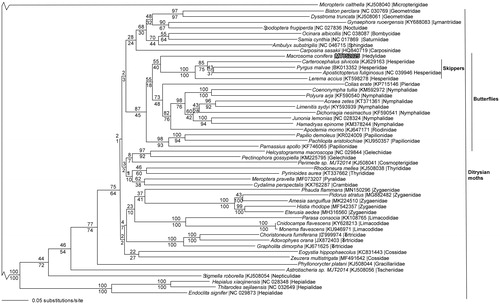Figures & data
Figure 1. Maximum likelihood phylogeny (GTR + I + G model, I = 0.1590, G = 0.3930, likelihood score 316053.05651) of Marcosoma conifera, 50 additional ditrysian Lepidoptera mitogenomes (including the Pyrgus malvae (Hesperiidae) mitogenome (Genbank BK013352, SRA SRR7174492 (Li et al. Citation2019)), and Micropterix calthella (Micropterigidae)(Timmermans et al. Citation2014) as an outgroup based on 1 million random addition heuristic search replicates (with tree bisection and reconnection). One million maximum parsimony heuristic search replicates produced an identical tree topology (parsimony score 76038 steps). Numbers above each node are maximum likelihood bootstrap values and numbers below each node are maximum parsimony bootstrap values (each from 1 million random fast addition search replicates). Note that the very long branches leading to Micropterix calthella and the basal ditrysian moths are not drawn to scale to facilitate visualing the branching patterns within the ditrysian moths.

Data availability statement
The data that support the findings of this study are openly available in GenBank of NCBI at https://www.ncbi.nlm.nih.gov, reference numbers PRJNA662440, MT852025, MT859412-MT859414, MT878224, and BK013352.
